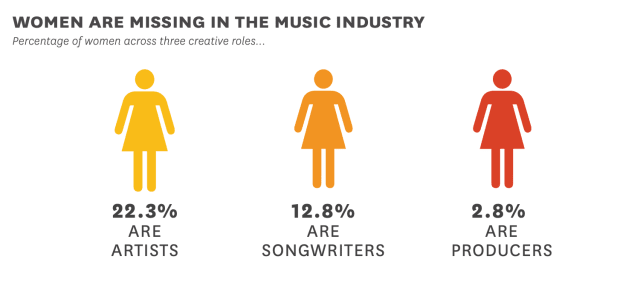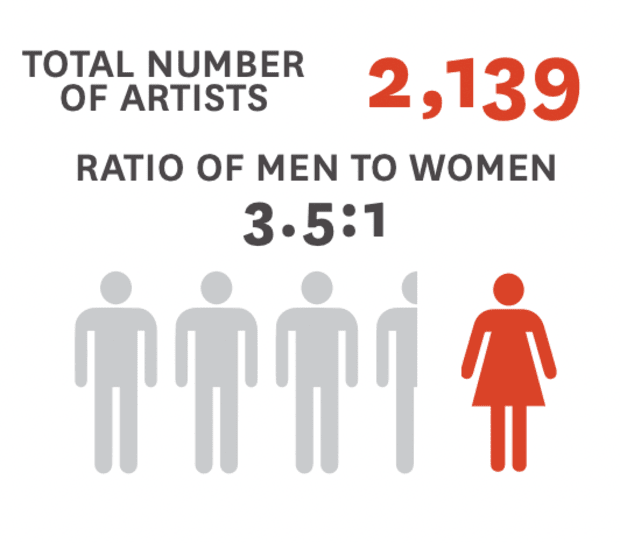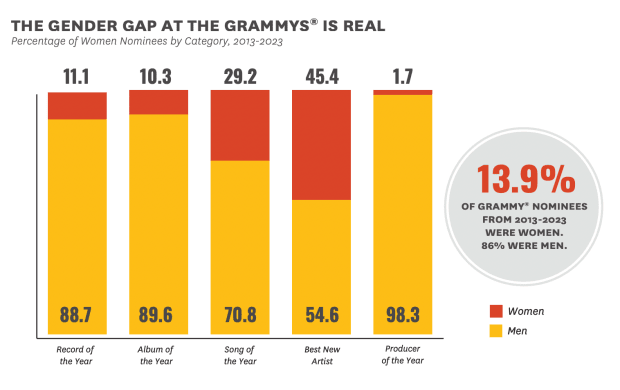New Study Suggests Lack of Representation In the Music Industry

While some areas have improved over the years, there's still a long way to go.
USC's Annenberg School for Communication and Journalism has released their 6th annual study exploring inclusion in the music industry—and the results are bleak.
While some areas have improved over the years, the study overall shows a lack of representation within the industry.
This study examined the gender and race of artists, songwriters and music producers behind the songs on the Billboard Year-End Hot 100 chart, as well as the demographics of nominees across six key categories at the Grammy Awards. Researchers examined 1,100 popular songs from 2012 to 2022, as well as Grammy nominees from 2013 to 2023.
Gender
According to USC's study, there were 160 artists on the Billboard Year-End Hot 100 chart in 2022. 69.4% were male and 30% were female and less than 1% of artists identified as nonbinary.
Across 11 years evaluated, 76.6% of artists were men and 22.3% were women. On the bright side, 2022 marked a new high for women artists across all 11 years. The percentage of female artists in 2022 (30%) was significantly higher than that of 2021 (23.3%) and 2012 (22.7%), suggesting an increase of women on the popular charts over time.
After evaluating the genres of all 1,100 songs, the study found that women artists were more likely to appear in pop songs (33%) and least likely to appear in hip-hop songs (13.4%).

Race and ethnicity
Race and ethnicity representation within popular songs looks more optimistic. In 2022, 50.6% of all artists were from an underrepresented racial or ethnic group, per the study, while 49.4% of artists were white.
Although this sounds propitious in theory, it actually represents an 8.4% point decline from the all-time high of 2020's clip of 59%. Across all 11 years, 48.1% of all artists were from an underrepresented racial group while 51.9% were white.
Keep in mind that while representation looks good in the charts, it’s a different story at the top. The percentage of Black female music executives is just 3%, according to a previous Annenberg report.

Songwriters and Producers
Across a total of 5,247 songwriters credited, 85.7% were men and 14% were women. The ratio of men to women songwriters was 6.8 to 1. Overall, 57% of songs across 11 years did not include a single female songwriter. In contrast, just six songs—less than 1%—were absent of male songwriters.
If you think the songwriting demographics look bad, the producing credits are even worse. Across 800 songs, 2.8% of all producers were women while 97.1% were men. This is a ratio of 34.1 men to every 1 woman. Moreover, of the 50 women credited as producers across the sample, 13—or 26%—were women of color.

The Grammys
From 2013 to 2023, 2,441 individuals were nominated for a Grammy Award across six major categories: Record of the Year, Album of the Year, Song of the Year, Best New Artist and Producer of the Year. Songwriter of the Year was introduced as a category at this year's 65th annual ceremony.
Of the 514 nominees in 2023, 84.8% were men and 15.2% were women. Just one nonbinary artist was nominated. Overall, women comprised only 13.9% of total nominees across all categories for the sampled years. Moreover, of the 340 women nominated in the last 11 years, 51.5% were white and 48.5% were from an underrepresented racial group.

While the report found progress for female performers in music, women behind the scenes saw little change and women of color continue to face challenges. The researchers’ solution? Hire more women.
You can read the full report here.




























